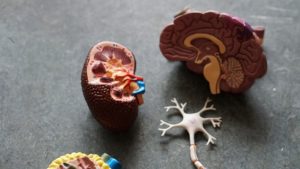HS and Pain
If you are reading this, you know a little something about HS pain. We all know how pain makes us feel physically and emotionally but not always why. I am a firm believer that you can fight something if you know how it works. What I want to do in this post is unpack how pain works and give you an idea of how it ticks. I will also provide some tips at the end for coping with pain.
Pain can be difficult for us to understand because we don’t always know what exactly hurts. For those of us with Hidradenitis Suppurativa (HS), we can usually see what’s causing the pain. Pain, whether you can see it or not, is valid pain.
But if you can’t find the cause, does that mean it’s all in your head? Well yes, it is but that goes for all pain. Rather it’s all in your neurons and receptors.
The Brain Bit

Look at the photo above. Notice the white tree-like structure – that is a neuron. A neuron is a brain cell that communicates with each other and receptors in the rest of your body.
The brain is in the central nervous system (CNS), but you also have a peripheral nervous system (PNS). Special sensory receptors called nociceptors in your PNS, keep track of what’s happening to the rest of the body and report back.
When you feel pain, the nociceptors send the message back to your CNS, through your spinal cord to your brain.
Electricity triggered by the release of chemicals is how your neurons and receptors send messages to each other. When you are potentially injured a message is sent to your brain. That message is pain. Your brain tries to decode the message into thoughts you can understand in hope that you will act.
This is an oversimplification but try to keep it in mind as we go on
What is Pain?
According to the International Association for the Study of Pain, pain is,
“an unpleasant sensory and emotional experience associated with actual or potential tissue damage or described in terms of such damage”
Pain is a message you send through your internal alarm system telling you that your body is under threat. The purpose is to motivate you to react and stop the cause.
Communication of pain is being sent through signals in our brain and is not a directly observable thing.
The experience of pain, so, it is unique to the person experiencing it.
Experiencing chronic pain over a long time can take a toll on your mental health. Not only can it stop you from doing the things you want to do, but it is emotionally draining.
What You Can Do About it?
As I have said before, I am not a medical professional and as such, I cannot offer you medical advice. You should always consult your doctor about pain management and other medical treatments.
What I can do is make some suggestions based on my own experience and what others have studied. These have worked for me and while they will not take your pain away completely, they may make things easier.
Here are my tips:
o Rest even if you can’t sleep. Lie down, listen to some music or watch a movie.
o Talk to someone. Pain is a heavy burden, make sure you have somebody to confide in. That might be a friend who can listen. If not, some wonderful therapists may be able to help.
o Keep a journal. Being able to write everything down can be cathartic. It can help you track your symptoms, which gives you a sense of control. It also provides your doctor with more information they can use to treat you.
o Keep track of the good stuff in your life. Write those down too because on your bad days they will remind you those good things happen and will again soon.
o There is much research on pain management going on,
-including into virtual reality,
– placebos
-and even yoga and mindfulness.
Science will find a way. Until then and above all, look after yourself!
Author Bio

Shannon Sweeney is a psychology and sociology student from Ireland. She is also living with HS and has a keen interest in lifestyle, wellbeing, and Hidradenitis Suppurativa.


